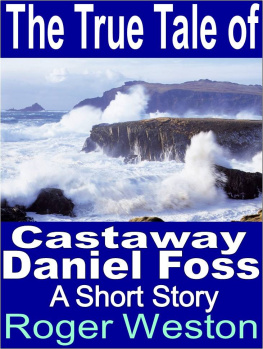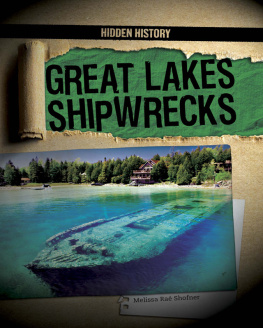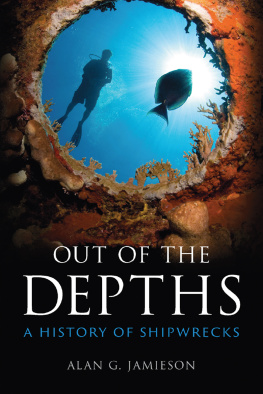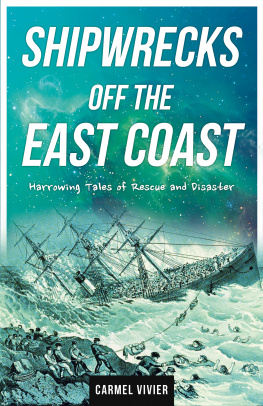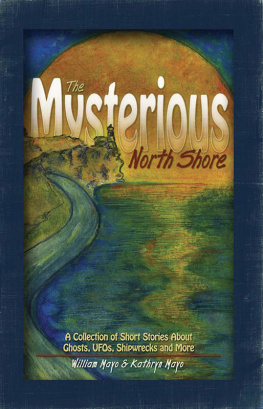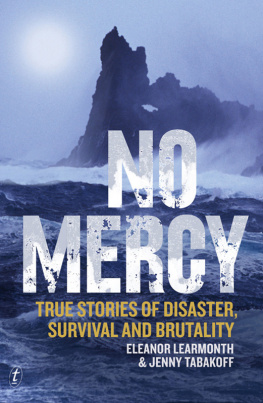Roger Weston - Shipwrecks: True Stories of Disaster at Sea
Here you can read online Roger Weston - Shipwrecks: True Stories of Disaster at Sea full text of the book (entire story) in english for free. Download pdf and epub, get meaning, cover and reviews about this ebook. year: 2019, genre: History. Description of the work, (preface) as well as reviews are available. Best literature library LitArk.com created for fans of good reading and offers a wide selection of genres:
Romance novel
Science fiction
Adventure
Detective
Science
History
Home and family
Prose
Art
Politics
Computer
Non-fiction
Religion
Business
Children
Humor
Choose a favorite category and find really read worthwhile books. Enjoy immersion in the world of imagination, feel the emotions of the characters or learn something new for yourself, make an fascinating discovery.

- Book:Shipwrecks: True Stories of Disaster at Sea
- Author:
- Genre:
- Year:2019
- Rating:4 / 5
- Favourites:Add to favourites
- Your mark:
- 80
- 1
- 2
- 3
- 4
- 5
Shipwrecks: True Stories of Disaster at Sea: summary, description and annotation
We offer to read an annotation, description, summary or preface (depends on what the author of the book "Shipwrecks: True Stories of Disaster at Sea" wrote himself). If you haven't found the necessary information about the book — write in the comments, we will try to find it.
Shipwrecks: True Stories of Disaster at Sea — read online for free the complete book (whole text) full work
Below is the text of the book, divided by pages. System saving the place of the last page read, allows you to conveniently read the book "Shipwrecks: True Stories of Disaster at Sea" online for free, without having to search again every time where you left off. Put a bookmark, and you can go to the page where you finished reading at any time.
Font size:
Interval:
Bookmark:
SHIPWRECKS
True Stories at Disaster at Sea
ROGER WESTON
Copyright 2019 by Weston Publishing Enterprises
All rights reserved.
Contents
Morro Castle
SS Sirio
Athenia
Empress of Ireland
Sultana
KANO MARU
Wilhelm Gustloff
Suevic
Brother Jonathan
Lexington
Lusitania
SS Norge
Panic, Mystery, and Heroism on the Morro Castle

Chief Radio Officer George Rogers did not look like your typical hero. He was a big, lumbering gentle giant, a slow-witted man who at times seemed lively, but at other times nodded off while talking to others. Nobody would have guessed that this man would face down elements of fire and stormeven at the risk of personal destruction in the flamesto save liveslives of those he did not even know. Yet according to his testimony, thats what happened.
Sometimes the most unlikely men rise to the occasion and thereby climb out of obscurity into the limelight of fame and public adulation. There was something unusual about George Rogers. Nothing in his appearance would have tagged him as a likely hero. He looked neither sharp, nor capable, or even decisive. But when he told of the actions he took in the heat of tragedy, nobody would ever see him in same way again.
The adversity began around 3 a.m. on September 8, 1934, on a ship called the Morro Castle , a ship that was about to go down in history and shock the entire country, from New Jersey to Oregon.
Not everyone had the capacity to rise on a storm tide the way George Rogers said he did. In fact, on this day in 1934, every crewman was tested to the limit of his character. It began early in the evening when Captain Robert Willmott made an unusual request. He had his dinner delivered to his cabin. Soon afterward, he complained of stomach pain. Not long afterwards, the severity of his condition became apparent when a crewman found him dead in his cabin.
The timing of Captain Willmotts death could not have been worse because the crew was left in a very tough situation. Naturally, Willmotts death cast a dark pall over the ship. The crew was shaken. It was bad enough to lose a good man and friend, but with two storms bearing down on the shipone being an unusually powerful noreaster, the other being the western fringes of a hurricanethe loss of their captain was especially stressful. The crew had to function at a high level while manning the ship in the midst of a ferocious sea. Waves ran high and wild. Wind blew as if generated by a Herculean fan. Sheets of rain flung themselves at the ship over and over. Visibility was limited. In these conditions, a new captain was needed, and Chief Officer William Warms assumed command . Other officers were promoted to new positions. This would be a challenge at any time, but in storm conditions, it was especially tough to have all the officers thrust into jobs that they are unfamiliar with.
If the crew was unprepared for the struggle in which they now found themselves, most of the passengers were no better off. Obviously, they had not come on this cruise to battle the elements and overcome their own propensities for weakness and human frailty. They had come on this voyage specifically to get away from their troubles. These were the depression years, and the Morro Castle was one of the most luxurious passenger liners on the ocean. It ran cruises to Cuba twice-a-week. The sole purpose of these cruises was to beat the Prohibition laws. This was a party boat that offered a smorgasbord of pleasures on the way to Cuba, which was itself a garden of temptations. Passengers came to relax and party, not fight for their lives. The band played rumbas late into the night. Laughter and lively conversations filled the lounges. After the captains death was announced, however, all festivities were canceled for the evening. This was the final night of the cruise, and since the public festivities were not to be, the parties moved to private quarters. Alcohol flowed freely, and this, combined with the increasingly violent rolling of the ship, brought many partiers to their knees from seasickness. Soon the parties cleared out, and many nauseated people hit the sack early.
If the passengers were ill-prepared for disaster, the ship itself was no better off. Passengers would naturally assume that even in such adverse conditions, at least the company would have taken all precautions for their safety. The company officials probably did take the precautions that they could foresee, but this was 1934, and they did not have the benefit of hindsight. They did not know that the Morro Castle would provide an example of failure that would lead to higher safety standards for American ships of the future. While their ship was promoted as fireproof, it was actually more like a tinderbox. Sure, the ship had fire doors, but incomprehensibly, there was a six-inch gap above the doors. This defeated the whole point. It was like cracking open the door of a woodstove; it fanned the flames to greater intensity, like a dragon blowing fire throughout the ship. It helped turn the fire into a burning storm. At the same time, the ship had a state-of-the-art ventilation system that piped in fresh ocean air, a kind of natural air-conditioning. It seemed like a good idea, but with the unusual combination of conditions on this tragic night, the ventilation system turned the ship into a crematorium. It was bad enough to have heavy winds blowing on the coals outside; it was even worse to have a ventilation system doing the same thing inside.
If the ventilation worked against the odds of survival, the 42 fire hydrants were little help. They might have helped if they had worked, but the pressure was inadequate. Only a limited number of these were employed, but that was only part of the problem. Fire hydrants are of little use unless the crew is competent in their use. The crew of the Morro Castle was under-trained and under-drilled. This was unfortunate because the ship was built with highly flammable materials. The paint burned. The walls burned. The floors burned. It was almost as if the ship was soaked in gasoline. Ignite a ship like that in wicked winds, and what you get is a flame-blasted infernoa funeral pyre.
Ships would be much safer after 1934, thanks to the lessons learned from the tragedy of the Morro Castle . Building standards were changed so that a scenario like this would not happen again. Crews were thereafter required to drill in the use of safety equipment. Non-flammable materials were required. But none of this helped the poor souls on the Morro Castle .
The tragic combination of a flustered crew, sea-sick passengers, high-winds, and a highly flammable ship, led to a shocking disaster at sea, but why? Ships dont just start burning for no reason. Even under these circumstances, there should have been no problem. What could possibly start a fire on the ship as it cruised eight miles off the New Jersey coast? It was reported that around 3 a.m., a crewman saw something very unusual and suspicious. Smoke was pouring out of a locker in the reading room. Upon hearing about this, Chief Officer W.F. Warms, who had taken over as captain for the deceased Robert Wilmott, sent an officer to extinguish the flames, but when the officer tried, there was an explosion that he attributed to gasoline in the locker. This is what set off the fatal fire.
Later on, Captain Warms attributed the fire in the reading room to an incendiary in the locker. He believed this because this was not the first fire on the Morro Castle . There had been a fire in the ships hold during a previous voyage, and on that occasion, charred paper was found in the hold. The previous fire had been put out, and Warms believed this one could also be extinguished. For this reason, he delayed giving the order to send an SOS message. After a thirty minute delay, it became clear that the fire was out of control, and the SOS message was sent by George Rogers.
Font size:
Interval:
Bookmark:
Similar books «Shipwrecks: True Stories of Disaster at Sea»
Look at similar books to Shipwrecks: True Stories of Disaster at Sea. We have selected literature similar in name and meaning in the hope of providing readers with more options to find new, interesting, not yet read works.
Discussion, reviews of the book Shipwrecks: True Stories of Disaster at Sea and just readers' own opinions. Leave your comments, write what you think about the work, its meaning or the main characters. Specify what exactly you liked and what you didn't like, and why you think so.

